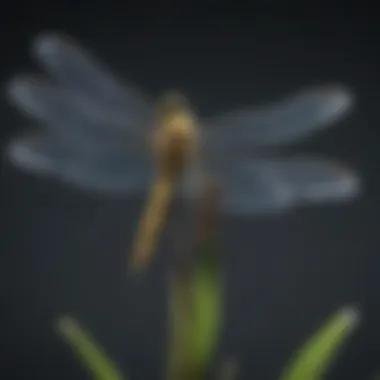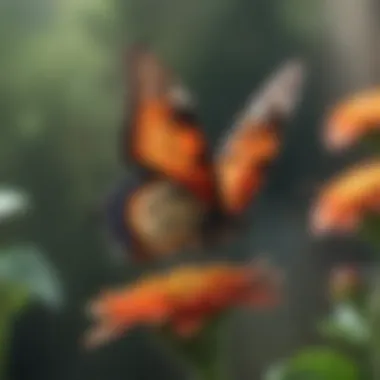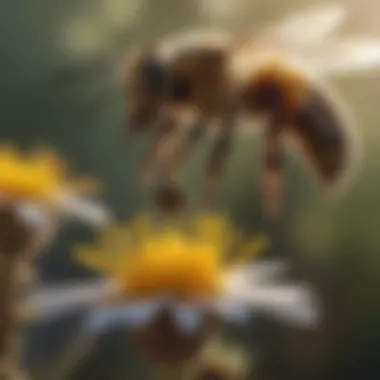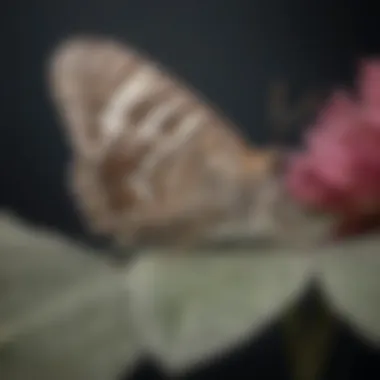Intriguing Insights into the World of Aerial Insects


Animal Species Profile
In the realm of flying bugs, a diverse array of fascinating species takes to the skies, showcasing unique physical characteristics and behaviors. From delicate butterflies fluttering elegantly to resilient dragonflies darting with precision, each species offers a glimpse into the intricate world of aerial insects. Their natural habitats span across varied ecosystems, from lush rainforests to arid deserts, demonstrating the adaptability of these airborne creatures. In terms of behavior, flying bugs exhibit interesting social interactions, such as mating dances or territorial displays, which play significant roles in their survival and reproductive success.
Introduction
Flying bugs are often overlooked yet central to the intricate tapestry of our ecosystems. This article delves into the captivating world of these aerial creatures, shedding light on their diverse species, behaviors, and ecological significance. From the intricacies of insect flight to the crucial role flying bugs play in maintaining the balance of nature, readers will embark on a journey of discovery through the often underappreciated realm of airborne insects.
Unveiling the Enigmatic World of Flying Bugs
Importance of Flying Bugs in Ecosystems
Flying bugs hold a pivotal role in ecosystems, serving as crucial pollinators, seed dispersers, and food sources for various organisms. Their ability to pollinate plants facilitates reproduction, contributing significantly to biodiversity. Moreover, by serving as prey and predators, flying bugs form intricate food webs that regulate populations, thus maintaining ecosystem stability. The conservation of flying bugs is imperative for sustaining healthy ecosystems due to their irreplaceable ecological functions.
Evolutionary Adaptations for Flight
The evolutionary adaptations of flying bugs for flight have enabled them to thrive in diverse environments and evade predators efficiently. Their lightweight exoskeletons, intricate wing structures, and strategic flight patterns showcase the remarkable evolutionary advancements that optimize their aerial capabilities. The evolution of flight in bugs has conferred them with a competitive edge in foraging, escaping threats, and engaging in complex mating rituals, highlighting the significance of these adaptations in their survival and reproduction.
Types of Flying Bugs
Butterflies and Moths
Butterflies and moths, known for their vibrant wing patterns and delicate flight, are essential pollinators crucial in supporting plant diversity. Their co-evolution with flowering plants highlights their distinctive role in ensuring plant reproduction and ecological resilience. However, their susceptibility to habitat loss and climate change poses significant challenges to their populations, emphasizing the need for conservation strategies to safeguard these enchanting insects.
Beetles and Weevils
Beetles and weevils, with their diverse shapes, sizes, and behaviors, constitute a significant portion of flying bug species. Their varied diet preferences and adaptive capacities enable them to thrive in a myriad of ecosystems, contributing to nutrient recycling, seed dispersal, and pest control. Despite their beneficial roles, certain beetle and weevil species are agricultural pests, requiring integrated pest management practices to mitigate potential economic losses.


Flies and Mosquitoes
Flies and mosquitoes, often perceived negatively due to their association with disease transmission, fulfill critical ecological roles as decomposers and pollinators. Their swift flight capabilities and specialized feeding strategies highlight the diverse adaptations these insects possess. While some fly and mosquito species pose health risks to humans and animals, others are integral components of aquatic and terrestrial food chains, underscoring the multifaceted contributions of these flying bugs to ecosystem functioning.
Flight Mechanisms
In the intriguing section of Flight Mechanisms, we delve deep into the essential aspects that govern airborne insects' ability to navigate the skies. Understanding the Flight Mechanisms is crucial in appreciating the complexity of flying bugs and their survival strategies. By unraveling the mysteries behind how insects achieve flight, we gain valuable insights into their evolution and adaptability.
Insect Wings and Aerodynamics
Wing Structures
Exploring the intricate design of insect wings unveils a world of precision and efficiency. These Wing Structures are not just mere appendages but finely-tuned instruments that enable remarkable feats of aerial acrobatics. One significant characteristic of Wing Structures is their ability to vary in shape and size, catering to the diverse needs of different insect species. This versatility ensures that insects can adapt their flight patterns based on specific environmental conditions, thereby enhancing their efficiency in navigation.
Flight Patterns
The study of Flight Patterns exposes us to the mesmerizing choreography of flying bugs in motion. Each species has a distinct set of Flight Patterns that dictate their behavior in the air. From graceful butterfly flights to erratic mosquito movements, these patterns play a vital role in how insects interact with their surroundings. Understanding these Flight Patterns offers valuable insights into insect behavior and survival strategies, shedding light on the intricate dance of life in the skies.
Navigational Skills of Flying Bugs
Use of Visual Cues
Visual cues serve as guiding beacons for flying bugs in their quest for navigation. These cues act as visual landmarks that help insects map their surroundings and determine their flight paths. The key characteristic of Visual Cues lies in their ability to provide real-time information to insects, allowing them to make split-second decisions during flight. While Visual Cues enhance precision in navigation, they also carry the risk of distraction or misinterpretation, posing challenges for flying bugs in unknown territories.
Utilization of Pheromones
The fascinating world of Pheromones unfolds as flying bugs harness chemical signals to communicate and navigate their environment. The key characteristic of Pheromones is their role in signaling towards food sources, mates, or potential dangers. By utilizing these chemical cues, insects can establish intricate communication networks that guide their flight paths and interactions. However, the reliance on Pheromones also exposes insects to the risks of signal interference or exploitation, highlighting the delicate balance between chemical communication and survival in the insect realm.


Ecological Impact
In this article, the focus is on exploring the vital Ecological Impact of flying bugs in various ecosystems. These airborne insects play a crucial role in maintaining the balance of their habitats. By delving into the intricate interactions between flying bugs and their environments, readers will grasp the significance of these seemingly small creatures. From pollination to seed dispersal, flying bugs contribute substantially to the overall health and diversity of ecosystems worldwide. Each species has a unique ecological niche, making their presence integral to the web of life.
Pollination and Seed Dispersal
Role in Plant Reproduction
The Role in Plant Reproduction undertaken by flying bugs underscores their irreplaceable contribution to the ecosystem. With their specialized behaviors and anatomical structures, these insects aid in the transfer of pollen between flowers, facilitating fertilization and subsequent seed production. This process is pivotal for the continuity of plant species and the sustenance of floral populations. The efficiency and precision of flying bugs in pollination make them indispensable agents in the reproductive cycle of numerous plants. Despite challenges such as habitat destruction, these insects persist as key players in sustaining floral biodiversity.
Contribution to Biodiversity
The Contribution to Biodiversity by flying bugs further highlights their ecological significance. By partaking in pollination and seed dispersal activities, these insects promote genetic diversity within plant populations, ultimately enhancing the resilience of ecosystems. Additionally, the presence of diverse flying bug species ensures a robust network of interactions that support various flora and fauna. The intricate relationships formed through these processes contribute to the overall stability and functionality of biodiversity hotspots. While facing threats such as pesticide exposure, the conservation of flying bug populations remains paramount to safeguarding global biodiversity.
Predatory Behavior
Insect Prey Relationships
Examining the Insect Prey Relationships maintained by flying bugs unveils a complex web of predator-prey dynamics crucial for ecosystem balance. These insects actively hunt and consume other invertebrates, playing a significant role in regulating prey populations. Through targeted predation, flying bugs help control insect populations that may otherwise engage in destructive behaviors. The intricate adaptations and hunting strategies displayed by these predators highlight their evolutionary success in exploiting available resources efficiently.
Impact on Pest Control
The Impact on Pest Control exerted by flying bugs exemplifies their valuable role in agricultural and ecological contexts. By targeting pest species that threaten crops and natural habitats, these insects provide a natural and sustainable form of pest management. Their ability to suppress pest populations reduces the reliance on chemical pesticides, thereby mitigating environmental risks associated with conventional control methods. Recognizing the ecological services rendered by flying bugs in pest regulation underscores the importance of conservation efforts to maintain balanced predator-prey relationships.
Threats and Conservation
In this section, we delve into the critical aspects of threats and conservation related to flying bugs, shedding light on the challenges these creatures face in today's changing world. The intricate interconnectedness of ecosystems is highlighted through the lens of flying bugs, emphasizing the delicate balance that must be maintained for the well-being of both the insects and their surrounding environment. By understanding the threats posed to flying bugs and the role of conservation efforts, readers will gain valuable insights into the necessity of protecting these essential species.


Habitat Loss and Climate Change
Effects on Flying Bug Populations:
Within the realm of flying bug populations, habitat loss and climate change act as primary drivers of decline, significantly impacting the survival and abundance of various species. The specific effects of these environmental changes manifest in disrupted breeding patterns, altered foraging behaviors, and decreased reproductive success among flying bugs. This section dives deep into the implications of habitat loss and climate change on flying bug populations, underscoring the urgent need for proactive measures to mitigate these detrimental effects and preserve the diversity of airborne insects.
Conservation Efforts:
Conversely, conservation efforts play a pivotal role in safeguarding flying bug populations and their habitats from further degradation. By implementing targeted conservation strategies such as habitat restoration, creation of protected areas, and awareness campaigns, concerted efforts can be made to counteract the harmful consequences of habitat loss and climate change. The emphasis is placed on the significance of conservation initiatives in ensuring the long-term sustainability of flying bug populations and fostering a harmonious coexistence between these insects and their surrounding ecosystems.
Pesticide Use and Pollution
Impacts on Insect Communities:
The indiscriminate use of pesticides and pollution poses a grave threat to insect communities, including flying bugs, by contaminating their breeding grounds, altering food sources, and compromising their overall health. The detrimental impacts of pesticide use and pollution on flying bugs are multifaceted, encompassing issues of toxicity, habitat destruction, and ecological disruption. This section illuminates the far-reaching consequences of these practices on insect communities, underscoring the need for stringent regulations and sustainable alternatives to protect the delicate balance of nature.
Sustainable Practices:
In response to the detrimental effects of pesticide use and pollution, sustainable practices emerge as viable solutions to mitigate environmental harm and safeguard insect populations. By adopting organic farming methods, promoting integrated pest management, and minimizing chemical inputs, individuals and communities can significantly reduce the negative impact on flying bugs and restore ecological equilibrium. The narrative delves into the advantages of sustainable practices in promoting biodiversity, enhancing soil health, and mitigating the risks associated with conventional agricultural techniques, underscoring the transformative potential of sustainable approaches in nurturing healthy insect populations and resilient ecosystems.
Conclusion
In the grand finale of our exploration into the world of flying bugs, it becomes evident that these aerial creatures play a vital role in maintaining ecological balance. Their significance spans across various ecosystems, contributing to pollination, seed dispersal, and even pest control. Understanding the importance of flying bugs is crucial for appreciating the intricate web of life that sustains our planet. Through this article, readers have been exposed to the often overlooked but essential functions that flying bugs fulfill in nature.
Appreciating the Wonders of Flying Bugs
Importance in Nature
Diving deep into the essence of the 'Importance in Nature', we uncover a foundational element that highlights the intrinsic value of flying bugs in the broader natural world. These creatures serve as crucial pollinators, ensuring the reproduction of numerous plant species. Additionally, their role in seed dispersal aids in the propagation of diverse flora, fostering biodiversity. The key characteristic of this 'Importance in Nature' lies in its irreplaceable contribution to the sustainability of ecosystems. The unique feature of this significance is its ability to maintain the delicate balance of interconnected life forms, showcasing the intricate dependencies present in nature. While the advantages of this element are clear in promoting ecosystem health, one must also acknowledge its limitations, particularly in the face of habitat destruction and climate change.
Call to Conservation Action
Transitioning to the realm of 'Call to Conservation Action', we encounter a pivotal aspect that underscores the necessity of safeguarding flying bug populations. Through highlighting the declining numbers of certain species and the threats they face due to human activities, a sense of urgency is instilled in preserving these valuable insects. The key characteristic of this call lies in its plea for individuals and communities to take proactive steps towards protecting flying bugs and their habitats. By raising awareness about sustainable practices and the harmful impacts of pesticide use and pollution, this initiative serves as a beacon for instigating positive change. The unique feature of this conservation action is its potential to rally collective efforts towards fostering an environment where flying bugs can thrive. While its advantages are evident in promoting biodiversity and ecosystem resilience, challenges may arise in implementing conservation measures effectively amidst competing interests and limited resources.







